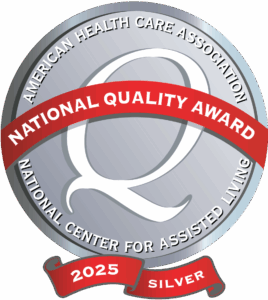When seniors are recovering from an illness, injury or surgery, taking part in a senior rehabilitation program is vital to restoring functionality, reducing pain and improving quality of life. Rehabilitation for seniors often includes a mix of physical, occupational and speech therapies all designed with the individual’s specific needs and abilities in mind.
“The goal of therapy is to alleviate pain and return to mobility,” says Jean Brooks, Senior Vice President of Rehabilitation, American Senior Communities. ‘What seniors may not realize is that therapists know how to work with older adults so that exercise can be done in a safe and effective manner. Research has shown that seniors can increase strength well into their 90s!”
Why is Physical Therapy for Seniors Important for a Successful Recovery?
Physical therapy is a particularly important component in a successful recovery because it improves an individual’s strength, flexibility and mobility. Physical therapy for seniors is beneficial for a variety of reasons, including:
- Reducing the risk of a fall. One of the most common reasons a senior needs physical therapy is to recover from a fall. Falls are the leading case of accidents among seniors and often result in a bone fractures and other injuries. A physical therapist can teach seniors techniques to prevent a fall.
- Lowering risk of injury. Physical therapy helps seniors learn how to maintain their stability as it relates to gravity when they’re mobile. This awareness helps reduce the risk of injuries and re-injury.
- Decreasing pain from chronic conditions. Physical therapy can help alleviate discomfort from conditions like arthritis or osteoporosis and offset any future symptoms.
- Lessening the need for prescription drugs. Seniors are often on a wide variety of prescription drugs to help manage their chronic pain. However, a physical therapy regimen could help reduce the need for medications, and could be a more cost-effective form of treatment.
- Maintaining an independent lifestyle. The quicker seniors are able to recover from an illness or injury and manage their pain allows them to lead an active, independent lifestyle for a longer period of time.
Common Types of Physical Therapy for Seniors
Physical therapists are trained in a variety of different types of therapy that help people return to their normal lifestyles as quickly as possible. The main types of physical therapy for seniors include:
Geriatric physical therapy
Geriatric physical therapy places a special emphasis on the needs of aging adults. It helps treat conditions like arthritis, osteoporosis, cancer, joint replacement and balance disorders. Specialized programs are designed to help restore mobility, increase fitness levels and reduce overall pain.
Orthopedic physical therapy
An orthopedic physical therapist helps treat injuries of the musculoskeletal system, as well as help individuals recover from orthopedic surgeries. The goal is to restore function to the muscles, bones, joints, tendons and ligaments.
Cardiopulmonary physical therapy
When individuals have had a heart attack, or have other cardiovascular or pulmonary conditions such as Chronic Obstructive Pulmonary Disease (COPD) or pulmonary fibrosis, cardiopulmonary physical therapy can help increase endurance and functional independence.
Neurological physical therapy
Neurological physical therapy focuses on the brain and the body, making it slightly different from other types of physical therapy. When individuals have neurological conditions such as Alzheimer’s disease, ALS, Parkinson’s disease or have suffered a brain injury, a neurological physical therapist focuses on teaching them to adapt to visual, mobility, balance and muscle loss impairments to more easily complete activities of daily living.
“Physical therapists work on the mind-body relationship, helping folks to adapt to impairments so they can move better in their environment,” Brooks says. “These techniques have shown great strides in working with MS and brain injuries, including strokes and other neurological conditions.”
Brooks says that women who have had a mastectomy can also benefit from physical therapy, by helping them increase their range of motion and reduce swelling.
She recommends a thorough evaluation be done by a therapist to help them design the best program for you.
For post operation rehabilitation, consider Moving Forward Rehabilitation at an American Senior Communities location near you. Contact the ASC Referral Line at 888-996-8272 or referralline@ASCSeniorCare.com for additional information.




